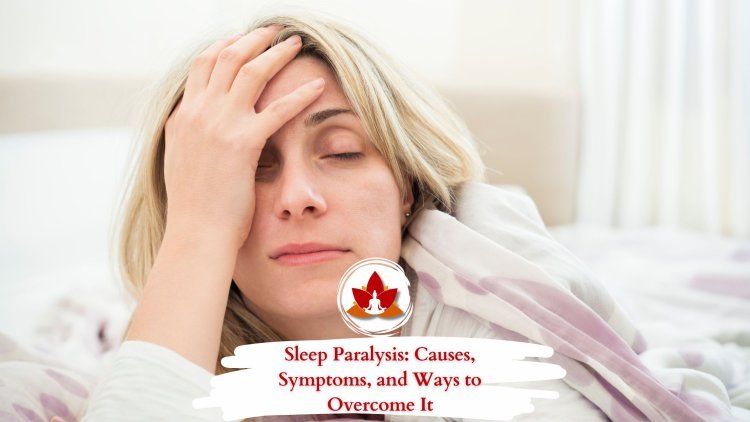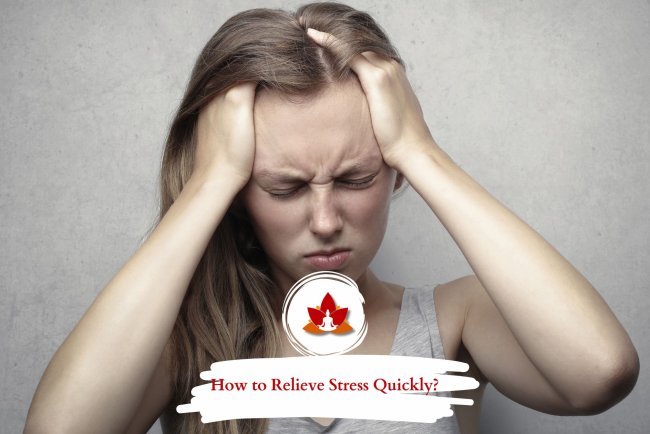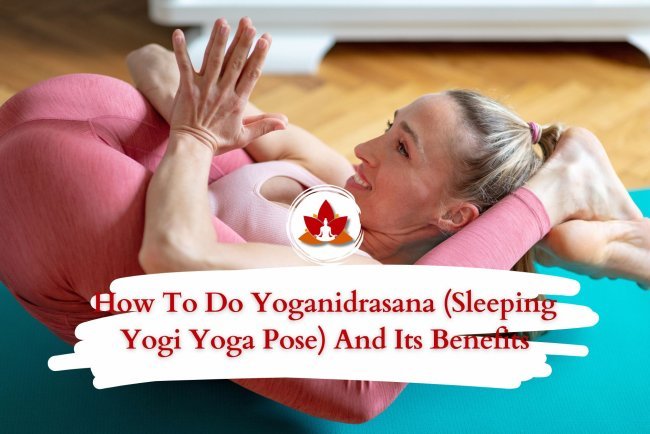Sleep Paralysis: Causes, Symptoms, and Ways to Overcome It

Sleep paralysis can be a deeply unsettling experience. In this article, you’ll learn about the types, causes, symptoms, and practical ways to prevent or manage sleep paralysis so you can rest easier.
Have you ever felt wide awake yet completely unable to move—or even make a sound? Almost as if an invisible force were holding you down? You may try with all your strength to roll over, lift your arms, or cry out, but your body remains frozen. To make matters worse, some people see shadowy figures, ghostly shapes, or feel an eerie presence in the room, causing intense fear and panic.
If this sounds familiar, you’ve likely experienced sleep paralysis. This frightening phenomenon occurs during the transition between wakefulness and sleep, leaving you conscious but temporarily paralyzed.
The good news? Although it feels terrifying, sleep paralysis is not dangerous—and there are ways to handle it. With the right knowledge, techniques, and coping strategies, you can break free from its grip and even prevent episodes altogether.
What does sleep paralysis feel like?
During an episode of sleep paralysis, you may feel or see things that aren’t really there. These vivid experiences—known as hallucinations—tend to happen at the edges of sleep, unlike dreams and nightmares which usually appear later in the sleep cycle.
There are two main types of hallucinations linked to sleep paralysis: those that occur as you’re falling asleep and those that happen as you’re waking up.
Hypnagogic Hallucinations (Falling Asleep)
Also called waking dreams, hypnagogic hallucinations occur when you’re drifting off to sleep. Research suggests that around 37% of people experience them.
-
Most common: visual phenomena such as faces, shapes, landscapes, or kaleidoscopic patterns.
-
Less common: auditory sensations (like hearing voices or sounds) or physical feelings (such as falling or floating).
Unlike dreams, which often have a storyline or dialogue, hypnagogic hallucinations are typically fragmented and lack narrative flow.
Hypnopompic Hallucinations (Waking Up)
These hallucinations appear as you’re transitioning from sleep to wakefulness. Like hypnagogic experiences, they are most often visual—fleeting images, shadows, or figures in the room. Occasionally, they may involve sounds or bodily sensations.
Hypnopompic hallucinations are less common, affecting about 12% of the population.
Both types of hallucinations can feel incredibly real, which is why sleep paralysis can be such a frightening experience. But understanding when and why they happen is the first step to reducing fear and regaining control.
Sleep Paralysis and Lucid Dreaming
Although sleep paralysis and lucid dreaming may seem similar, they are very different experiences that occur during different stages of sleep and create very different sensations. Both, however, can be unsettling and may affect sleep quality.
-
Lucid dreaming takes place during REM sleep. In this state, you become aware that you are dreaming and may even feel in control of the dream’s direction. Lucid dreams can feel empowering, as if you’re consciously shaping your own destiny. Importantly, they do not involve the frightening immobility that comes with sleep paralysis. You may even feel awake inside the dream, though your body is still asleep.
-
Sleep paralysis, on the other hand, typically occurs as you enter or exit REM sleep. Unlike lucid dreams, it leaves you feeling completely conscious yet unable to move or speak—a sensation that can be terrifying.
Some people actively try to induce lucid dreams through methods like dream journals, computer games, or even technology-assisted techniques. While this can be fascinating, it may carry risks—especially for those already struggling with sleep issues or mental health conditions, such as dissociation or difficulty separating dreams from reality.
By understanding the differences between lucid dreaming and sleep paralysis, you can better navigate your sleep experiences and protect your overall well-being.
What exactly is sleep paralysis?
Sleep paralysis is a temporary condition in which you are awake but unable to move or speak, usually right before falling asleep or just as you’re waking up.
Normally, your brain relaxes the muscles in your arms and legs during sleep to keep you from acting out your dreams. But during sleep paralysis, your body gets “stuck” between sleep phases—your mind is alert, yet your muscles remain frozen.
While the experience can feel frightening, it isn’t dangerous. By identifying possible triggers and addressing underlying causes, you can often reduce or even prevent future episodes.
Who Gets Sleep Paralysis?
Around 1 in 5 people will experience sleep paralysis at some point in their lives. It often begins during the teenage years and may continue into the 20s and 30s. Research suggests there may even be a genetic link, making some individuals more prone to episodes than others.
Several factors can increase the likelihood of sleep paralysis, including:
-
Poor or insufficient sleep
-
Irregular sleep schedule (e.g., shift work or frequent travel)
-
Mental health conditions such as stress, anxiety, or bipolar disorder
-
Sleeping on your back
-
Other sleep disorders, like narcolepsy or restless leg cramps
-
Certain medications, including those prescribed for ADHD
-
Substance or drug use
While sleep paralysis can be unsettling, recognizing the triggers that may apply to you is the first step toward prevention and better sleep quality.
10 surprising facts every sleeper should know
Sleep paralysis can feel like something out of a horror movie—but understanding it takes away much of the fear. Here are ten key facts every sleeper should know:
1. Episodes Are Usually Very Brief
Although it may feel like an eternity, most episodes of sleep paralysis last only a few seconds. In some cases, they can stretch to a few minutes, but they almost always pass quickly.
2. The Science Behind Sleep Paralysis
During REM sleep (Rapid Eye Movement), your muscles naturally become paralyzed to prevent you from acting out your dreams. Sleep paralysis happens when you wake up while your body is still in REM mode—your mind is alert, but your muscles remain frozen.
3. Two Types of Sleep Paralysis
-
Hypnagogic sleep paralysis – occurs while falling asleep. Here, the body shuts down before the brain fully “gets the memo.”
-
Hypnopompic sleep paralysis – happens while waking up. In this case, the brain wakes first, but the body stays in sleep mode.
4. Strange Hallucinations and Sensations
Many people report vivid, often frightening hallucinations during sleep paralysis: shadowy figures in the room, whispers, or even a feeling of pressure on the chest. These experiences are intense but simply the brain misfiring as it transitions between sleep and wakefulness.
5. Common Triggers
Certain factors increase the risk of sleep paralysis, including:
-
Stress or anxiety
-
Irregular sleep schedules
-
Mental health conditions
-
Sleep disorders like narcolepsy
-
Substance use or certain medications
6. It Often Begins in Adolescence
Sleep paralysis typically starts in the teen years and may continue into the 20s or 30s. Frequency varies widely—some people experience it weekly, while others only once in a lifetime.
7. You’re Not Alone
Sleep paralysis affects about 8% of the population. Among certain groups, like students (28%) and psychiatric patients (31.9%), the numbers are even higher.
8. Not Always a Recurring Problem
For many, sleep paralysis is a one-time event. Others may face repeated episodes throughout their lives.
9. Knowledge Reduces Fear
Understanding what’s happening can dramatically reduce the terror. Knowing that sleep paralysis is temporary and harmless makes episodes easier to manage.
10. Scary but Harmless
Yes, it can feel terrifying—but sleep paralysis itself causes no physical harm. Once you know the signs and triggers, you’ll see it for what it is: an unusual but harmless quirk of the sleep cycle.
Sleep paralysis may feel like a nightmare come alive, but arming yourself with knowledge makes it far less frightening—and much easier to handle.
What Triggers Sleep Paralysis?
So what exactly sends the body into that strange twilight state between waking and sleeping? While the exact cause can vary, science points to several common triggers:
1. Sleep Cycle Disruptions
An irregular sleep schedule confuses your biological clock and increases the likelihood of sleep paralysis.
Typical triggers include: jet lag, shift work, or simply not getting enough sleep.
2. Health Conditions
Certain medical and psychiatric conditions raise the risk. These include:
-
Narcolepsy
-
Anxiety and mood disorders
-
Obstructive sleep apnea
-
Post-traumatic stress disorder (PTSD)
3. Medications and Substances
Some substances that affect the nervous system can play a role, such as:
-
Certain antidepressants
-
Alcohol
-
Recreational or “party” drugs
4. Genetics
Sleep paralysis sometimes runs in families, suggesting a hereditary component. If multiple relatives experience frequent episodes, it may be worth discussing with a healthcare provider.
5. Lifestyle and Other Factors
-
Sleeping on your back may increase the chances of an episode.
-
High stress and anxiety are strongly linked to sleep paralysis.
Often, these factors interact with one another, making it a combination of triggers rather than a single cause. By recognizing your own risk factors and making simple lifestyle adjustments, you can greatly reduce the frequency and intensity of episodes.
What Tests Are Used to Diagnose Sleep Paralysis?
Your health care provider might order a test if they suspect an underlying sleep disorder that leads to sleep paralysis such as narcolepsy. You may need:
-
An all-night sleep test (polysomnogram): The test tracks your breathing, heart rate and brain waves during sleep. It can allow doctors to see an attack of sleep paralysis occur or identify problems such as sleep apnea.
-
Multiple sleep latency test (MSLT): This test tracks the speed at which you fall asleep and what type of sleep you have during a nap. The test identifies conditions like narcolepsy.
7 effective ways to cope with sleep paralysis
There isn’t a single guaranteed way to stop sleep paralysis, but a multi-pronged approach focused on sleep quality and mental well-being can make a big difference. Here are seven effective strategies to help you manage it:
1. Stick to a Regular Sleep Schedule
Going to bed and waking up at the same time every day helps synchronize your body’s internal clock, reducing the likelihood of episodes.
2. Create a Sleep-Friendly Bedroom
Make your room cozy, dark, and quiet to encourage deep rest. A cooler temperature often improves sleep quality, so if you tend to wake up hot, try lowering the thermostat before bedtime.
3. Reduce Stress Levels
Stress is one of the biggest triggers. Try progressive muscle relaxation, deep breathing, or journaling before bed to calm the mind and prepare for restful sleep.
4. Practice Good Sleep Hygiene
Avoid caffeine, heavy meals, and screens close to bedtime. Good habits make it easier for your body to transition smoothly into sleep and reduce disruptions.
5. Talk It Out
Sharing your experiences with friends, family, or a therapist can ease anxiety and normalize what you’re going through. If sleep paralysis causes ongoing distress, professional support may provide relief.
6. Try Mindfulness and Meditation
Incorporating mindfulness or meditation into your nighttime routine helps quiet racing thoughts and reduce the chances of sleep disturbances.
7. Consult a Healthcare Provider
If episodes are frequent or interfere with daily life, it’s wise to seek professional guidance. Treating underlying sleep disorders or mental health conditions can significantly reduce or even eliminate sleep paralysis.
By combining these strategies, you can regain control, reduce fear, and improve your overall sleep quality—making sleep paralysis far less disruptive.
When Should You See a Healthcare Provider?
Occasional sleep paralysis is usually harmless, but if episodes become frequent, severe, or disruptive to daily life, it’s time to consult a healthcare provider. In some cases, sleep paralysis may be linked to an underlying sleep disorder or medical condition that can be treated.
Seeking professional advice not only helps rule out other conditions but also provides you with personalized strategies to improve your sleep and overall well-being.
What Questions Should I Ask My Healthcare Provider?
If you decide to speak with a healthcare provider about sleep paralysis, going in with a list of questions can help you get the most out of your visit. Consider asking:
-
What could be causing my sleep paralysis?
-
Are there ways to shorten or stop an episode when it happens?
-
Should I also consult a mental health professional?
-
Do you recommend any specific treatment or lifestyle changes?
-
What are the possible side effects of the treatment options?
Having these questions ready not only gives you clarity but also helps your provider tailor advice and treatment to your unique situation.
How to Prevent Sleep Paralysis in the Moment
If you ever find yourself caught in the grip of sleep paralysis, remember—you’re not powerless. With the right strategies, you can take back control and ease the experience. Try these techniques:
-
Start small: Focus on moving your fingers or toes. Even the tiniest movement can help break the paralysis.
-
Control your breath: Take slow, steady breaths to reduce panic and calm your nervous system.
-
Move your eyes: Try looking side-to-side or down toward your feet to re-engage your muscles.
-
Distract your mind: Tune in to surrounding sounds or visualize a peaceful, calming scene.
-
Reassure yourself: Remind yourself the episode is temporary and harmless—you are safe.
-
Make a sound: Concentrate on producing a grunt, hum, or cry. This effort can help your body snap out of paralysis.
-
Use imagery techniques: Picture yourself moving—like standing up or sitting in bed—to trigger real movement.
-
Seek support: Having a trusted partner nearby or sharing your experiences with friends can ease fear and reduce future anxiety.
While it can feel overwhelming in the moment, practicing these techniques helps you regain control faster, reduce fear, and shorten the duration of an episode.
Relaxation and meditation techniques for better sleep
When it comes to managing sleep paralysis, relaxation and meditation are powerful allies. By cultivating calmness through mindfulness, deep breathing, or guided meditation, you can ease both body and mind, making episodes less likely and easier to handle.
-
Quiet the mind: Meditation helps lower stress and anxiety—two major triggers of sleep paralysis.
-
Improve sleep quality: A consistent meditation practice supports a healthier sleep cycle, making it easier to fall asleep peacefully and stay asleep.
-
Build coping strategies: Focusing on breath and body awareness during an episode can help you stay calm, regulate your breathing, and move past the paralysis more quickly.
Think of mindfulness as your travel companion on the journey to restful, serene sleep. With regular practice, it not only reduces the fear of sleep paralysis but also enhances your overall well-being.
A Note from Rishikesh Yogkulam
Experiencing sleep paralysis can leave you feeling anxious, unsettled, and even fearful of going back to sleep. After regaining movement, you may find yourself replaying the episode—wondering what just happened, whether it will occur again, or if anyone would even believe your experience. These emotions can disrupt your rest and make it harder to feel energized and focused during the day.
If sleep paralysis has become a recurring issue, don’t let fear or uncertainty hold you back from seeking support. A healthcare provider can help identify possible causes, recommend effective treatments, and suggest self-care practices to reduce your risk of future episodes.
Remember—you are not alone, and with the right guidance, sleep paralysis can be managed so you can return to restful, restorative sleep.
FAQs
What causes sleep paralysis?
The most common triggers include irregular sleep patterns, lack of sleep, high stress levels, certain medications, substance use, and sleep disorders such as narcolepsy. Genetics may also play a role, as sleep paralysis sometimes runs in families.
How can I break free from sleep paralysis?
Focus on small movements like wiggling your toes or fingers, moving your eyes, or taking slow, deep breaths. Distracting your mind with calming thoughts or visualizing yourself moving can also help. If someone else is nearby, having them wake you can end the episode more quickly.
Can sleep paralysis harm me?
Although it can feel terrifying, experts agree that sleep paralysis is not physically dangerous. However, if it happens often enough to disrupt your sleep or affect daily life, it’s important to consult a healthcare provider.
Does sleep paralysis actually wake you up?
Not exactly. Sleep paralysis occurs in the transition between wakefulness and REM sleep. While you may feel awake, your body is still in a dream state. Attempting small movements can help you fully awaken and end the paralysis.
Knowing the facts can help you replace fear with understanding—making sleep paralysis less overwhelming and easier to manage.
What's Your Reaction?


























